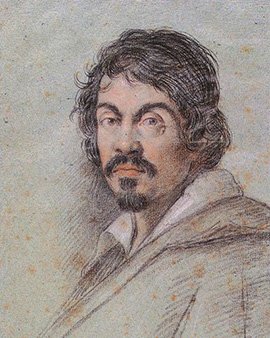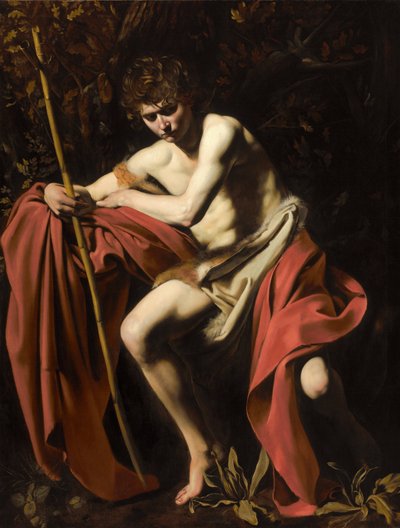Michelangelo Merisi was born in 1573 in Caravaggio, a town in the province of Bergamo. He is known in the professional world under the main name of Caravaggio. His life was not always steady and sources report that he indulged in debauchery that brought him into conflict with the law. He fled on several occasions, but managed to escape into the protection of religious leaders of the Church and the Maltese Order.
Caravaggio studied painting in Milan and Venice. His creative energy was untiring and he soon enjoyed the intercession of his patrons, who praised him for his clarity, naturalism and lovingly executed details, especially an art dealer Valentin, who provided him with connections to wealthy collectors, including various cardinals. As early as 1589, at the age of 16, the elites were so surprised by his self-confidence and the certainty of his artistic expression, something that otherwise only painters in the middle or at the end of their painting careers were able to experience. Around 1600 he enjoyed a wide range of recognition, but his self-inflicted events threatened his artistic development and led him straight to ruin.
In 1605 he had to flee from Rome to Genoa, the following year he fled from the grip of justice in the direction of Naples. There he worked for the Grand Master of the Order of Malta, but again he got into conflicts with the dignitaries. During his wanderings, new works of incomparable beauty were created for churches and monasteries, although Caravaggio was always a driven man. Three years before his death, he painted a picture of Christ and one with Mary, the Child and Saint Anne, both of which exerted an intense influence on the work of many artists of this and subsequent generations. Caravaggio's painting of Mary had in part scratched the ideals of beauty prevailing at the time, because he painted honest facts, such as the trampling of a snake as a symbol of evil, in the two by three meter painting, true to detail.
Thus, painters such as Peter Paul Rubens from the Netherlands and other artists from Verona, Genoa, Piedmont and Tuscany were so taken with his painting style that they followed his example. Especially the simplicity and the representation of light and shadow were often the model and the artists tried to use these techniques like Caravaggio did. Caravaggio is thus considered a pioneer in the development of Baroque painting.
×





.jpg)
.jpg)
.jpg)
.jpg)
.jpg)
.jpg)
.jpg)
.jpg)
.jpg)
.jpg)
.jpg)
.jpg)
.jpg)
.jpg)
.jpg)
.jpg)
.jpg)
.jpg)
.jpg)
.jpg)


.jpg)
.jpg)
.jpg)
.jpg)
.jpg)
.jpg)
.jpg)
.jpg)
.jpg)
.jpg)
.jpg)
.jpg)
 - (MeisterDrucke-62161).jpg)
 - (MeisterDrucke-62161).jpg)
.jpg)
.jpg)
.jpg)
.jpg)
.jpg)
.jpg)
.jpg)
.jpg)
.jpg)
.jpg)
.jpg)
.jpg)
.jpg)
.jpg)
.jpg)
.jpg)
.jpg)
.jpg)
.jpg)
.jpg)
_-_(MeisterDrucke-115359).jpg)
_-_(MeisterDrucke-115359).jpg)
.jpg)
.jpg)
.jpg)
.jpg)
.jpg)
.jpg)
.jpg)
.jpg)
.jpg)
.jpg)
.jpg)
.jpg)
.jpg)
.jpg)
.jpg)
.jpg)
_-_(MeisterDrucke-107895).jpg)
_-_(MeisterDrucke-107895).jpg)
.jpg)
.jpg)
.jpg)
.jpg)
.jpg)
.jpg)
.jpg)
.jpg)
.jpg)
.jpg)
.jpg)
.jpg)
.jpg)
.jpg)
.jpg)
.jpg)
_-_(MeisterDrucke-86433).jpg)
_-_(MeisterDrucke-86433).jpg)
.jpg)
.jpg)
.jpg)
.jpg)
.jpg)
.jpg)
.jpg)
.jpg)
.jpg)
.jpg)
.jpg)
.jpg)
 Caravaggio - (MeisterDrucke-653862).jpg)
 Caravaggio - (MeisterDrucke-653862).jpg)
.jpg)
.jpg)
.jpg)
.jpg)
.jpg)
.jpg)
.jpg)
.jpg)
.jpg)
.jpg)
.jpg)
.jpg)
.jpg)
.jpg)
.jpg)
.jpg)
.jpg)
.jpg)
.jpg)
.jpg)
.jpg)
.jpg)
.jpg)
.jpg)
.jpg)
.jpg)
.jpg)
.jpg)
.jpg)
.jpg)
_-_(MeisterDrucke-96878).jpg)
_-_(MeisterDrucke-96878).jpg)
.jpg)
.jpg)
.jpg)
.jpg)
_-_(MeisterDrucke-101732).jpg)
_-_(MeisterDrucke-101732).jpg)
.jpg)
.jpg)
.jpg)
.jpg)
.jpg)
.jpg)
.jpg)
.jpg)
.jpg)
.jpg)
.jpg)
.jpg)
.jpg)
.jpg)
.jpg)
.jpg)
.jpg)
.jpg)
.jpg)
.jpg)
 - (MeisterDrucke-268984).jpg)
 - (MeisterDrucke-268984).jpg)
.jpg)
.jpg)
.jpg)
.jpg)
.jpg)
.jpg)
 - (MeisterDrucke-92404).jpg)
 - (MeisterDrucke-92404).jpg)
.jpg)
.jpg)
.jpg)
.jpg)
.jpg)
.jpg)
.jpg)
.jpg)
.jpg)
.jpg)
.jpg)
.jpg)
.jpg)
.jpg)
 - (MeisterDrucke-72543).jpg)
 - (MeisterDrucke-72543).jpg)
.jpg)
.jpg)
.jpg)
.jpg)
 c1594 - (MeisterDrucke-260672).jpg)
 c1594 - (MeisterDrucke-260672).jpg)
.jpg)
.jpg)




